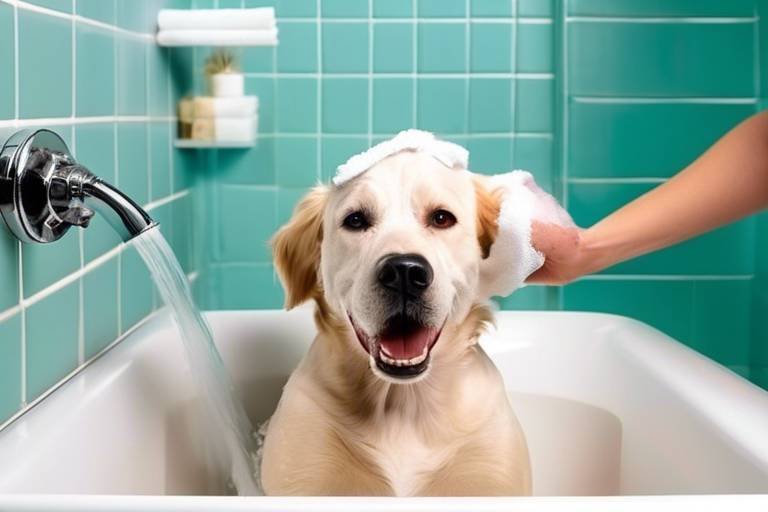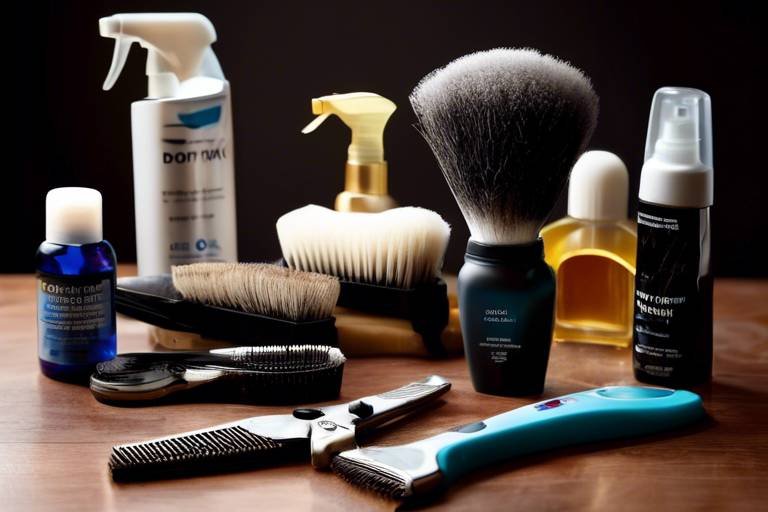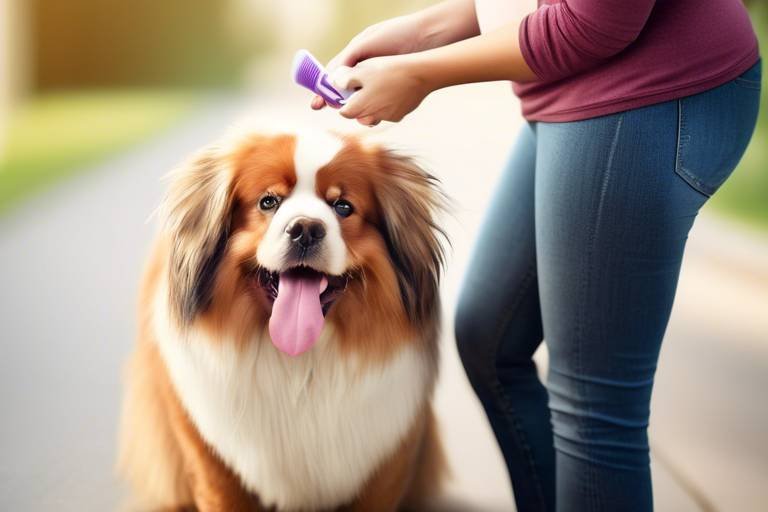How to Deal with Fleas and Ticks During Grooming
Grooming your pet is not just about keeping them looking fabulous; it's also a vital part of maintaining their overall health. However, one of the most dreaded aspects of grooming is dealing with pesky fleas and ticks. These tiny parasites can cause a world of discomfort for your furry friend and can even lead to serious health problems if left unchecked. So, how do you tackle these unwelcome guests during grooming sessions? Let's dive into some effective strategies that will help you manage fleas and ticks, ensuring your pet remains healthy and your home stays clean.
Understanding the enemy is half the battle. Fleas and ticks have life cycles that can make them quite resilient. Fleas reproduce rapidly, laying hundreds of eggs that can easily infest your home. Ticks, on the other hand, latch onto your pet and can transmit diseases like Lyme disease if not removed promptly. Hence, knowing their behaviors and life cycles is crucial for effective management during grooming. Think of it like a game of chess; the more you know about your opponent, the better your chances of winning.
Now, let’s talk about the tools of the trade. Having the right grooming tools can make a significant difference in your fight against fleas and ticks. For instance, a flea comb is an essential tool that can help you catch and remove fleas from your pet's coat. It’s specifically designed to trap fleas and their eggs, making it easier for you to identify infestations early on. Additionally, using a flea comb can be a bonding experience for you and your pet, turning a chore into a moment of affection.
When using a flea comb, it’s important to take your time. Section your pet's fur and comb through slowly, ensuring you cover all areas. This method not only helps in effectively removing fleas but also allows you to check for any skin irritations or other issues that may need attention. After each stroke, make sure to clean the comb to prevent any fleas from jumping back onto your pet. Regular maintenance of your grooming tools is also crucial. A well-maintained flea comb will not only last longer but will also be more effective in keeping your pet pest-free.
Tick removal is another critical aspect of grooming. Ticks can pose serious health risks, and knowing how to remove them safely is essential. When you spot a tick, use a pair of fine-tipped tweezers to grasp it as close to your pet’s skin as possible. Pull upward with steady, even pressure. Avoid twisting or jerking the tick, as this can cause parts of the tick to break off and remain in your pet’s skin. After removal, clean the bite area and your hands with rubbing alcohol. Remember, the sooner you remove a tick, the better for your pet's health.
Prevention is always better than cure. While grooming is an excellent opportunity to check for fleas and ticks, implementing preventative measures is crucial in keeping them at bay. Topical treatments are a popular choice among pet owners. These solutions can provide a protective barrier against fleas and ticks, making it less likely for them to latch onto your pet in the first place. However, it’s important to consult your veterinarian to find the best option for your furry friend.
Environmental control is equally important. Maintaining a clean home can significantly reduce the risk of flea and tick infestations. Regularly vacuuming carpets, washing pet bedding, and using pest control methods on your lawn can create an environment that is less inviting to these pests. Consider using flea and tick prevention products in your home and yard to create a comprehensive defense strategy.
In conclusion, dealing with fleas and ticks during grooming doesn’t have to be a nightmare. By understanding these pests, using the right tools, and employing preventative measures, you can ensure your pet remains comfortable and healthy. So, the next time you groom your pet, remember these tips and turn what could be a stressful experience into a positive and rewarding one.
- How often should I groom my pet to check for fleas and ticks?
It’s recommended to groom your pet at least once a week, especially during flea and tick season. - What should I do if I find fleas or ticks on my pet?
Immediately use a flea comb or tweezers to remove them and consult your veterinarian for appropriate treatment options. - Can I use human flea treatments on my pet?
No, human flea treatments can be harmful to pets. Always use products specifically designed for animals. - How can I prevent fleas and ticks in my home?
Regular cleaning, vacuuming, and using pest control products can help keep your home free from these pests.

Understanding Fleas and Ticks
Fleas and ticks are more than just a nuisance; they are pesky parasites that can wreak havoc on your beloved pets. Understanding these little invaders is crucial for maintaining your pet's health and comfort. Fleas, tiny insects that measure about 1/8 inch, can jump up to 7 inches high, making them incredibly agile. They feed on the blood of their hosts and can multiply rapidly, leading to a full-blown infestation in no time. Did you know that a single female flea can lay up to 50 eggs a day? That’s a staggering number!
On the other hand, ticks are arachnids and are often larger than fleas, with some species growing as big as a marble when engorged with blood. Unlike fleas, ticks latch onto their hosts for extended periods, sometimes several days, while they feast. This prolonged attachment can lead to serious health issues, including Lyme disease and other tick-borne illnesses. Understanding their life cycles is essential for effective management and prevention. Both fleas and ticks have distinct life stages: egg, larva, pupa, and adult. This means that even if you manage to get rid of the adults, their eggs and larvae can still pose a threat.
To effectively combat these parasites, it’s vital to recognize their behavior. Fleas thrive in warm, humid environments and can often be found in your pet's bedding, carpets, and even on your furniture. Ticks, however, are more likely to be found in grassy or wooded areas, waiting for a host to pass by. This difference in habitat means that your approach to prevention and management must consider where your pet spends most of their time.
Here’s a quick overview of their life cycles:
| Stage | Fleas | Ticks |
|---|---|---|
| Egg | Laid on host, falls into environment | Laid in the environment |
| Larva | Develops in dark, humid areas | None |
| Pupa | Forms a cocoon, can remain dormant | None |
| Adult | Jumping, feeding on hosts | Attaches to host, feeds for days |
By understanding the life cycles and habitats of fleas and ticks, you can take proactive steps to protect your pets. Regular grooming sessions, combined with proper cleaning of your home, can significantly reduce the risk of infestations. Remember, knowledge is power, and being informed about these parasites is the first step in ensuring your furry friends remain happy and healthy!
- How can I tell if my pet has fleas or ticks? Look for signs like excessive scratching, biting at the skin, or the presence of flea dirt (tiny black specks) in their fur.
- What should I do if I find a tick on my pet? Use a tick removal tool or tweezers to grasp the tick as close to the skin as possible and pull it out steadily. Clean the area afterward.
- Can fleas and ticks affect humans? Yes, both can bite humans, and ticks can transmit diseases to people as well.

Grooming Tools for Flea and Tick Removal
When it comes to keeping our furry friends happy and healthy, having the right grooming tools is absolutely essential, especially in the battle against fleas and ticks. These pesky parasites can turn a blissful grooming session into a nightmare if not managed properly. So, let’s dive into some effective tools that can help you tackle these unwelcome guests!
First up, we have the flea comb. This is not just any comb; it’s specifically designed to catch and remove fleas from your pet's coat. The fine-toothed design is perfect for sifting through fur, making it easier to spot those little critters. Regularly using a flea comb during grooming can help you identify infestations early, which is crucial for effective treatment. Imagine finding a needle in a haystack—this comb acts like a magnet, attracting fleas and their eggs while leaving your pet’s coat looking fabulous!
Using a flea comb properly is an art. Start by sectioning your pet's fur into manageable parts. This way, you can focus on one area at a time, ensuring that you don’t miss any fleas hiding out. Glide the comb slowly through the fur, allowing it to catch any fleas or eggs. It’s almost like searching for treasure in a buried chest—patience is key! After each stroke, make sure to dip the comb in soapy water to drown the fleas you’ve collected. This not only keeps your comb clean but also helps in tracking your progress.
To maximize the effectiveness of your flea comb, follow these simple steps:
- Start with a clean, dry coat.
- Section the fur to ensure thorough combing.
- Comb slowly and steadily, checking for fleas and eggs.
- Dip the comb in soapy water after each stroke to dispose of the fleas.
Just like any tool, maintaining your flea comb is crucial for its longevity and effectiveness. After each grooming session, rinse the comb under hot water to remove any debris. For deeper cleaning, soak it in a mixture of water and mild soap, then rinse thoroughly. This simple maintenance routine helps prevent the spread of parasites and keeps your grooming tools in prime condition. Think of it as giving your tools a little spa day—after all, they work hard to keep your pet healthy!
Ticks can pose serious health risks to pets, so it’s vital to have the right tools and techniques at your disposal. A good pair of tick tweezers or a tick removal tool can make all the difference. These tools are designed to grasp the tick firmly without squeezing its body, which can cause harmful bacteria to be released into your pet's bloodstream. When you find a tick, gently pull it straight out, ensuring you remove the entire head. It’s like performing a delicate operation—precision is everything!
Having these grooming tools on hand not only helps in effectively removing fleas and ticks but also ensures that your pet remains comfortable and healthy. A clean pet is a happy pet, and with the right tools, you can create a grooming routine that keeps those pesky parasites at bay!
Flea Combs
When it comes to keeping your furry friends happy and healthy, are your best allies. These specially designed tools are not just any ordinary comb; they are crafted with fine, closely spaced teeth that effectively catch and remove fleas from your pet's coat. Imagine trying to catch tiny fish with a net that has wide holes—it's simply not going to work, right? Similarly, a regular comb won't do the trick when it comes to tackling those pesky fleas. By using a flea comb, you can identify infestations early, ensuring that your pet remains comfortable and free from irritation.
Using a flea comb is straightforward, but there’s a technique to it that can make a world of difference. First, you’ll want to section your pet’s fur, just as you would when styling hair. This allows you to focus on one area at a time, ensuring that no flea goes unnoticed. As you gently comb through the fur, you’ll want to move slowly and methodically. This not only helps in catching the fleas but also gives you a chance to spot any flea dirt or eggs that may be present. Think of it as a treasure hunt—each section reveals more about your pet's coat and any hidden invaders.
Now, let’s talk about maintenance because even the best tools need a little TLC. After each grooming session, it’s crucial to clean your flea comb thoroughly. This can be done by rinsing it in warm, soapy water to remove any trapped fleas, eggs, or dirt. If you want to go the extra mile, consider sanitizing it with a solution of equal parts water and vinegar. This not only keeps the comb in good condition but also helps prevent the spread of any parasites. Remember, a clean tool is an effective tool!
In case you're wondering, flea combs come in various styles and sizes to suit different breeds and fur types. Some may even have ergonomic handles for a more comfortable grip during those longer grooming sessions. When choosing a flea comb, look for one that fits well in your hand and feels comfortable to use. You want to make the grooming experience as enjoyable as possible for both you and your pet.
To sum it up, incorporating a flea comb into your grooming routine is an effective strategy for managing flea infestations. Not only does it help maintain your pet's coat, but it also serves as a preventive measure against future infestations. With regular use, flea combs can be a game changer in ensuring your pet's health and happiness.
How to Use a Flea Comb
Using a flea comb is a straightforward yet effective way to ensure your furry friend is free from pesky fleas. To get started, sectioning the fur is key. You want to work in small areas, which allows you to focus on one section at a time and increases your chances of catching those sneaky little pests. Begin at the base of your pet's neck and gently comb through the fur towards the tail, making sure to apply enough pressure to catch fleas without hurting your pet. This method is similar to untangling a knot in your hair; patience is essential!
As you comb through, keep an eye out for not just fleas, but also their eggs, which are often hidden in the fur. These eggs can be tiny and white, making them hard to spot, so be vigilant. If you do catch a flea or an egg, it’s important to have a small bowl of soapy water nearby. This will serve as a trap; simply drop the caught fleas into the water to ensure they don’t jump back onto your pet or into your home.
After you’ve combed through a section, it’s a good idea to check the comb itself. If you notice any fleas or debris, clean the comb before moving on to the next section. You can use a tissue or a damp cloth to wipe the comb clean. This not only keeps your grooming process efficient but also prevents the spread of fleas back into your pet’s coat.
For optimal results, consider grooming your pet in a well-lit area, as this will help you see any fleas or eggs more clearly. If your pet has a thick or long coat, you might need to use a wide-toothed comb first to detangle the fur before using the flea comb. This two-step approach can make the process smoother and more effective.
Finally, remember that grooming should be a positive experience for your pet. Offer plenty of praise and maybe even a treat after each session to reinforce good behavior. This will help your pet associate grooming with something enjoyable, making future sessions easier and more effective.
Maintenance of Flea Combs
Maintaining your flea comb is not just a good practice; it's essential for ensuring that it remains effective in combating those pesky parasites. Imagine trying to catch fish with a broken net. Similarly, using a dirty or damaged flea comb can lead to ineffective grooming sessions, leaving your furry friend vulnerable to infestations. So, what does proper maintenance entail? Let's dive into the details.
First and foremost, after each grooming session, you should thoroughly clean your flea comb. This means removing any trapped fleas, eggs, or debris that may have accumulated during the process. A simple way to do this is to soak the comb in warm, soapy water for about 10-15 minutes. This will help loosen any stubborn particles. After soaking, use an old toothbrush to gently scrub the comb, paying special attention to the teeth where fleas tend to cling. Rinse it well and let it air dry completely before storing it away.
Additionally, sanitizing your flea comb periodically is crucial. You can use a solution of equal parts water and white vinegar to disinfect the comb. This not only helps eliminate any lingering parasites but also prevents the growth of bacteria that could harm your pet. Aim to sanitize your comb at least once a month or more frequently if you have multiple pets or if you're dealing with a heavy flea infestation.
Lastly, check the condition of your flea comb regularly. If you notice any bent or broken teeth, it's time to replace it. A damaged comb can cause more harm than good, potentially irritating your pet's skin or failing to catch fleas effectively. Investing in a quality flea comb can make a significant difference in your grooming routine, so don't hesitate to treat your pet to the best tools available!
In summary, keeping your flea comb in top shape involves:
- Regular cleaning after each use
- Sanitizing at least once a month
- Inspecting for damage frequently
By following these steps, you ensure that your flea comb remains a reliable ally in the battle against fleas and ticks, providing comfort and health for your beloved pets.
Q: How often should I use a flea comb?
A: It's recommended to use a flea comb at least once a week, especially during peak flea season or if your pet has been outdoors frequently.
Q: Can I use the same comb for multiple pets?
A: Yes, but make sure to clean and sanitize the comb between uses to prevent the spread of fleas or other parasites.
Q: What should I do if I find a tick while grooming?
A: Use a tick removal tool or tweezers to grasp the tick as close to your pet's skin as possible and pull straight out. Clean the area afterward and monitor for any signs of infection.
Q: Are there any special flea combs for different types of pets?
A: Yes, there are flea combs designed specifically for different fur types and lengths. Choose one that suits your pet's coat for the best results.
Tick Removal Techniques
Ticks are not just pesky little critters; they can pose serious health risks to your pets, making it crucial to know how to remove them safely and effectively. When you discover a tick on your furry friend, it’s essential to act quickly, but don’t panic! The proper technique can make all the difference in ensuring your pet remains healthy and free from infections. First things first, gather your materials. You will need a pair of fine-tipped tweezers, gloves, antiseptic, and a small container to safely dispose of the tick.
To begin, put on your gloves to protect yourself from any potential diseases the tick might carry. Using the tweezers, grasp the tick as close to your pet’s skin as possible. It’s important to pull straight out with steady, even pressure. Twisting or jerking can cause parts of the tick to break off and remain embedded in the skin, which can lead to infection. If you’re unsure about your technique, it might help to think of it like pulling a stubborn weed from the garden—steady and firm is the way to go!
Once you’ve successfully removed the tick, place it in the container and seal it. This way, you can take it to your veterinarian for identification, which is particularly important if your pet starts showing signs of illness. After removal, clean the bite area with antiseptic to prevent any potential infection. Keep an eye on the site for a few days to ensure there are no signs of irritation or infection.
Here’s a quick summary of the tick removal process:
| Step | Description |
|---|---|
| 1 | Put on gloves to protect yourself. |
| 2 | Use fine-tipped tweezers to grasp the tick close to the skin. |
| 3 | Pull straight out with steady pressure. |
| 4 | Place the tick in a sealed container for identification. |
| 5 | Clean the bite area with antiseptic. |
Remember, ticks can carry various diseases, such as Lyme disease and Rocky Mountain spotted fever, which can affect both pets and humans. If your pet starts to show symptoms like lethargy, loss of appetite, or unusual behavior after a tick bite, it’s essential to consult your veterinarian immediately. Prevention is always better than cure, so consider implementing regular grooming practices and using preventative treatments to keep ticks at bay.
In conclusion, knowing how to remove ticks properly can save your pet from potential health issues. Stay vigilant, and remember that your pet’s health and comfort should always be your top priority!
- How often should I check my pet for ticks? It’s best to check your pet for ticks after every outdoor adventure, especially during peak tick season.
- Can I use household tweezers for tick removal? Yes, but fine-tipped tweezers are recommended for better precision and to avoid leaving parts of the tick behind.
- What should I do if I can't remove the tick? If you're unable to remove the tick completely, contact your veterinarian for assistance.
- Are there any signs that my pet has been bitten by a tick? Look for signs of irritation at the bite site, lethargy, or sudden changes in behavior.

Preventative Measures for Fleas and Ticks
When it comes to keeping your furry friends safe from fleas and ticks, prevention is the name of the game. Just like you wouldn't wait for a rainy day to find an umbrella, you shouldn't wait for an infestation to take action. By implementing a few simple yet effective preventative measures, you can create a protective barrier against these pesky parasites. This not only helps in keeping your pets comfortable but also ensures a healthier living environment for everyone in your home.
One of the most effective strategies is to use topical treatments. These treatments come in various forms, including spot-on solutions, sprays, and powders. They work by either repelling or killing fleas and ticks on contact. It's essential to choose a product that suits your pet's needs and lifestyle. For instance, if your dog loves to swim, a waterproof formula would be ideal. Always consult with your veterinarian to find the best option for your pet. Here’s a quick look at some popular topical treatments:
| Product Type | Effectiveness | Duration |
|---|---|---|
| Spot-on Solutions | Highly effective against fleas and ticks | Up to 30 days |
| Sprays | Effective for immediate relief | Varies by product |
| Powders | Good for treating bedding and carpets | Varies by product |
Another critical aspect of prevention is environmental control. You can have the best treatments in the world, but if your home is a flea and tick paradise, they’ll keep coming back. Regular cleaning is essential. Vacuuming your home frequently, especially areas where your pets spend the most time, can significantly reduce the chances of an infestation. Don’t forget to wash your pet’s bedding and toys regularly, as these can harbor eggs and larvae. Here are some additional tips for maintaining a pest-free environment:
- Keep your yard tidy by mowing the lawn regularly and trimming bushes.
- Consider using outdoor flea and tick treatments for your yard.
- Seal any cracks or gaps in your home where pests might enter.
Lastly, regular grooming practices should be part of your routine. Grooming not only keeps your pets looking their best but also acts as a preventive measure. Using a flea comb during grooming sessions can help you spot and remove any fleas before they become a bigger problem. Plus, it’s a great way to bond with your pet! Make grooming a fun and rewarding experience for both of you.
In summary, taking proactive measures against fleas and ticks is crucial for your pet's health and comfort. By utilizing topical treatments, maintaining a clean environment, and incorporating regular grooming, you can significantly reduce the risk of these parasites invading your home. Remember, an ounce of prevention is worth a pound of cure!
Q1: How often should I apply flea and tick treatments?
A1: It depends on the product. Most topical treatments are applied monthly, but always check the label for specific instructions.
Q2: Can fleas and ticks affect humans?
A2: Yes, both fleas and ticks can bite humans, and ticks can transmit diseases. It's essential to keep your pets protected to prevent any risks to your family.
Q3: What should I do if I find a tick on my pet?
A3: Remove the tick carefully using a tick removal tool or tweezers, pulling straight out without twisting. Clean the area and monitor for any signs of infection. If you're unsure, consult your veterinarian.
Q4: Are there any natural remedies for flea and tick prevention?
A4: Some natural remedies include diatomaceous earth, essential oils, and apple cider vinegar. However, it's crucial to do thorough research and consult with a vet before using them.
Topical Treatments
When it comes to keeping your furry friends safe from pesky fleas and ticks, are often the go-to solution for pet owners. These treatments come in various forms, including spot-on solutions, sprays, and powders, and they are designed to provide long-lasting protection against these irritating parasites. The beauty of topical treatments lies in their ease of application and their ability to target the problem directly where it starts—on your pet's skin and fur.
Spot-on treatments, for example, are usually applied directly to the skin between your pet's shoulder blades, allowing the active ingredients to spread across the skin's surface. This method not only ensures that the treatment is effective but also minimizes the risk of your pet licking it off. Some popular active ingredients in these treatments include fipronil, imidacloprid, and permethrin, each working in unique ways to disrupt the life cycle of fleas and ticks.
It's crucial to choose a product that is specifically designed for your pet's species and weight. For instance, some treatments that are safe for dogs can be toxic to cats, so always read the labels carefully. Consulting with your veterinarian is also a wise move, as they can recommend the most suitable options based on your pet's health and lifestyle. Additionally, many topical treatments are available with added benefits, such as repelling mosquitoes and other biting insects, making them a versatile choice for pet owners.
To give you a clearer idea of how these treatments stack up, here’s a quick comparison table:
| Product Type | Active Ingredients | Duration of Effectiveness |
|---|---|---|
| Spot-on Treatment | Fipronil, Imidacloprid | 1 Month |
| Spray | Permethrin, Pyrethrin | Up to 30 Days |
| Powder | Insect Growth Regulators (IGRs) | Varies (Usually 1-3 Months) |
While topical treatments can be highly effective, they should not be the only line of defense in your anti-flea and tick arsenal. It's essential to combine these treatments with regular grooming and environmental controls to create a comprehensive prevention strategy. Remember, maintaining a clean environment and keeping your pet groomed will significantly enhance the effectiveness of topical treatments.
In summary, topical treatments offer a convenient and effective way to protect your pets from fleas and ticks. By carefully selecting the right product and following a holistic approach to pest management, you can ensure that your furry companions remain happy and healthy, free from the discomfort of these unwanted visitors.
- How often should I apply topical treatments? Most topical treatments need to be reapplied every month. Always refer to the product instructions for specific guidance.
- Can I use flea and tick treatments on my puppy or kitten? Yes, but ensure you choose a product that is safe for their age and weight. Consult your veterinarian for recommendations.
- Are there any side effects to topical treatments? While most pets tolerate these treatments well, some may experience mild skin irritation. If you notice any adverse reactions, contact your vet immediately.
Environmental Control
When it comes to keeping your furry friends safe from fleas and ticks, is key. It’s not just about treating your pet; you also need to tackle the environment they live in. Think about it: if your home is a flea and tick paradise, no amount of grooming or treatments will keep your pet safe for long. So, what can you do to create a pest-free zone? Let’s dive into some effective strategies.
First off, keeping your home clean is your first line of defense. Regular vacuuming is essential, especially in areas where your pet spends a lot of time. Fleas and ticks love to hide in carpets, rugs, and upholstery. By vacuuming frequently, you can suck up not just the adult pests but also their eggs and larvae. Remember to dispose of the vacuum bag or empty the canister outside to prevent any hitchhikers from re-entering your home.
Next, consider washing your pet's bedding and any blankets they frequently use. A hot wash can kill any fleas or ticks lurking in those cozy spots. It's recommended to wash these items at least once a week during flea and tick season. Additionally, don’t forget to clean your pet’s toys and grooming tools. A quick wash can make a big difference in keeping your pet safe.
Another effective measure is to treat your yard. If your pet spends time outdoors, it’s crucial to ensure your garden isn’t a breeding ground for these pests. Here are some tips for outdoor control:
- Keep your lawn trimmed and tidy, as tall grass and weeds provide perfect hiding spots for ticks.
- Consider using natural repellents like cedar chips or diatomaceous earth in your garden, which can deter fleas and ticks without harmful chemicals.
- Regularly clean up any debris, such as leaves or brush, where pests can thrive.
If you live in an area known for high flea and tick populations, you might want to consider professional pest control services. They can apply treatments that are safe for pets and children while effectively reducing pest populations in your home and yard.
Finally, don't forget about your pet's grooming routine. Regular grooming not only helps you spot any signs of fleas or ticks early but also keeps your pet’s coat healthy and less inviting to these pests. A good grooming session can also help you bond with your pet while keeping them safe and comfortable.
By taking these steps, you can create a safe environment for your pets, minimizing the risk of flea and tick infestations. Remember, a little effort in maintaining your home and yard can go a long way in ensuring your furry companions stay happy and healthy!
Q: How often should I vacuum my home to control fleas and ticks?
A: It's best to vacuum at least once a week, but during peak flea and tick season, consider vacuuming more frequently, especially in areas where your pet spends the most time.
Q: Are there any natural remedies for controlling fleas and ticks in my yard?
A: Yes! Natural remedies include using cedar chips, diatomaceous earth, and maintaining a clean yard by keeping grass short and removing debris.
Q: How can I tell if my pet has fleas or ticks?
A: Look for excessive scratching, biting at the skin, or visible fleas/ticks in the fur. Flea dirt (small black specks) may also be present in your pet's coat.
Q: What should I do if I find a tick on my pet?
A: Remove the tick carefully using a tick removal tool or tweezers, pulling straight out without twisting. Clean the area and monitor for any signs of infection.
Frequently Asked Questions
- What are the signs that my pet has fleas or ticks?
Common signs include excessive scratching, biting, or licking of the skin, visible fleas or ticks on the coat, and red or irritated skin. You may also notice flea dirt, which looks like small black specks, in your pet's fur.
- How often should I groom my pet to prevent fleas and ticks?
It's advisable to groom your pet at least once a week. Regular grooming helps you catch any flea or tick issues early and keeps your pet's coat healthy. If you live in a high-risk area, consider grooming more frequently.
- Can I use human shampoo to bathe my pet?
No, using human shampoo can disrupt your pet's skin pH balance and cause irritation. Instead, opt for a pet-specific shampoo that is designed to be gentle on their skin while effectively removing fleas and ticks.
- What is the best way to remove a tick from my pet?
The safest way to remove a tick is to use fine-tipped tweezers. Grasp the tick as close to the skin's surface as possible and pull upward with steady, even pressure. Avoid twisting or jerking, as this can cause parts of the tick to break off and remain in the skin.
- Are there any natural remedies to prevent fleas and ticks?
Yes, some natural remedies include using essential oils like lavender or cedarwood (diluted properly) and diatomaceous earth in your pet's environment. However, always consult your vet before trying new remedies to ensure they are safe for your pet.
- How can I treat my home for fleas and ticks?
To treat your home, vacuum regularly, wash your pet's bedding in hot water, and consider using flea and tick sprays or foggers designed for indoor use. Make sure to follow the instructions carefully for the best results.
- Are topical treatments safe for my pet?
Topical treatments are generally safe when used as directed. However, it's essential to consult your veterinarian to find the right product for your pet's specific needs and to avoid any potential adverse reactions.
- What should I do if my pet has a severe flea or tick infestation?
If your pet is heavily infested, it's best to consult your veterinarian for a comprehensive treatment plan. This may include professional grooming, topical treatments, and environmental control measures to eliminate the pests.



















